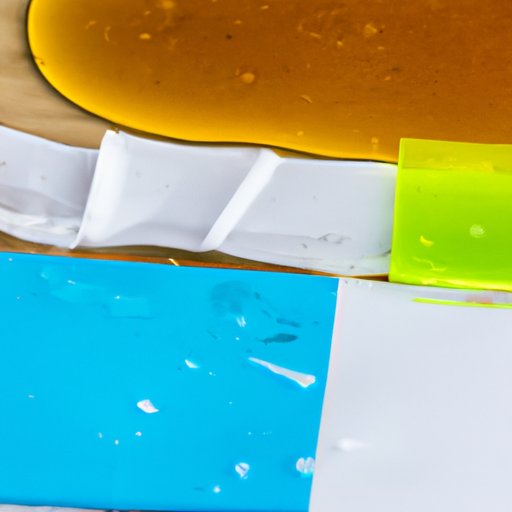
Introduction
Sticky residue is a common problem that can arise from various sources, such as adhesive labels, spills, or glue. It can be a source of frustration for many people, as it can be difficult to remove and can leave a mark or stain if not handled properly. This article provides a comprehensive guide on how to get sticky residue off various surfaces and materials, using simple household items that you may already have in your pantry or bathroom.
Rubbing Alcohol or Nail Polish Remover
Rubbing alcohol or nail polish remover can be an effective solution for removing sticky residue. Both contain solvents that dissolve the adhesive and make it easier to wipe or clean off. To apply, saturate a cotton ball or swab with rubbing alcohol or nail polish remover, and rub it onto the residue. You may need to repeat the process a few times, depending on the residue’s thickness.
One advantage of using rubbing alcohol or nail polish remover is that they are readily available and inexpensive. However, they can be harsh on some surfaces, such as painted or varnished ones, and can damage or discolor them. Also, ensure that the room is well-ventilated while using these products, and keep them away from children and pets.
Vinegar
Vinegar is another effective and natural solution for removing sticky residue. Its acidic properties allow it to break down the adhesive, making it easier to wipe or scrub off. To use vinegar, mix equal parts of vinegar and water, and soak a cloth or sponge in the solution. Then, apply the cloth or sponge onto the residue, and let it sit for a few minutes. Finally, rinse off the surface with warm water and dry it thoroughly.
One advantage of using vinegar over other methods is that it is a natural and safe option that can be used on most surfaces. However, vinegar may react with certain types of surfaces, such as granite, marble or stone, and may cause damage and discoloration. Therefore, it is advisable to test a small, inconspicuous area before applying vinegar more widely.
Baking Soda
Baking soda is a gentle, non-abrasive cleaning agent that can remove sticky residue from delicate surfaces. To use baking soda, mix two tablespoons of baking soda with enough water to make a paste. Then, apply the paste onto the residue using a cloth or sponge, and let it sit for a few minutes. Finally, rinse off the surface with warm water and dry it thoroughly.
One advantage of using baking soda is its mildness, which makes it safe for use on surfaces such as glass or plastic. However, baking soda may not be as effective on stubborn or thick residue, and the paste may leave a gritty residue if not rinsed off properly.
Oils
Vegetable or coconut oil can be used to loosen and dissolve sticky residue. To use, apply a few drops of oil onto the residue and let it sit for a few minutes. Then, rub the residue with a cloth or sponge until it comes off. However, oils may leave a greasy residue, which can be difficult to remove. To prevent this, rinse the surface with warm water and dish soap, and dry it thoroughly.
One disadvantage of using oils is that they may not work on all types of adhesive or residue. Also, oils can stain or discolor surfaces such as fabrics or paper, so use caution and test a small area first.
Tape
Tape can be used to lift off sticky residue. To use, stick a piece of tape onto the residue and press it firmly, then lift it off gently. You may need to repeat the process a few times, using fresh tape each time. However, tape may not work on thick or stubborn residue, and may leave a residue itself, which can be difficult to remove.
When using tape, use caution to prevent tearing or damaging delicate surfaces. Also, avoid using strong or duct tape, which may leave behind a sticky residue.
Final Thoughts
Removing sticky residue can be a frustrating task, but with the right tools and techniques, it can be done effectively and safely. Always test a small area before using any new product or method, and use caution to protect delicate or sensitive surfaces.
To prevent sticky residue in the future, try to avoid using stickers or labels on surfaces that cannot be easily cleaned. If you have persistent sticky residue or stains that cannot be removed, consider seeking professional cleaning or restoration services.
If you have any tips or tricks for removing sticky residue, or if you have any questions or comments, feel free to share them below.




